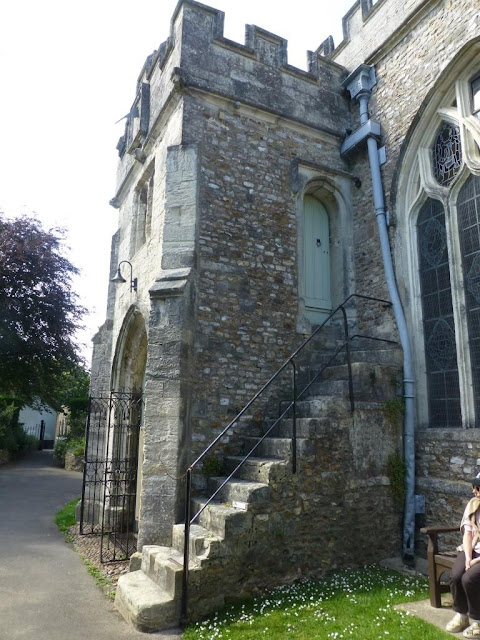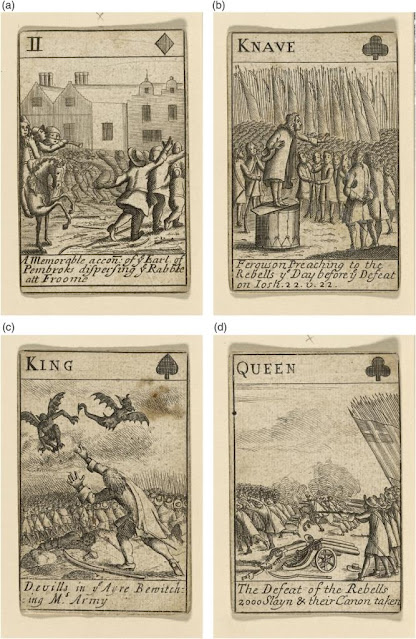Of all the buildings of Colyton, St Andrew’s Church with its octagonal lantern tower stands out as a local landmark. The church’s size is an indication of the wealth of the town and its merchants. From medieval times wool manufacture had been a major industry in Colyton. The Feoffees charter of 1546 mentions that there were six fulling mills along the River Coly, where wool was treated in a cleansing process.
The lower part of the two-storey church porch has been dated as from the 15th century. It was in a room above this porch that Colyton Grammar School began life, founded “for the goodly and virtuous education of children in Colyton forever”.
The priest’s door is set into
a beautifully carved frame in stone from the famous Beer quarries.
A view of the church interior
The oldest item on display in the church is this Anglo-Saxon cross, probably dating from the 10th century and described as ‘the best pre-Conquest sculpture in the county’.
The image of a lion on the Anglo-Saxon cross
This stone screen was installed by Thomas Brerewood, vicar of Colyton from 1522 to 1544
Naturally many American visitors to Colyton descended from Roger Conant will be interested in his father-in-law, the Feoffee John Clarke, born around 1520. Some of them may also be fascinated by the various church monuments with their transatlantic connections, including family links to early settlers in New England.
The Katherine Pole memorial monument
The Popham Colony is known as the first English colony in New
England, and was named after its financial backer Sir John Popham (1531-1607), noted
for presiding over the trial of Sir Walter Raleigh in his role as Chief Justice
of England.
Shown above is the memorial in St Andrew’s Church to Sir John Popham’s sister Katherine, wife of William Pole (1515-1587). She was the daughter of Alexander Popham (c.1504-1556), of Huntworth, Somerset.
The monument to Katherine shows her kneeling surrounded by her seven children.
Her nephew George Popham (1550-1608) sailed from Plymouth in 1607 with two ships and about 120 passengers and crew, landing in August at the mouth of the Kennebec River. Popham captained The Gift of God which became separated from the ship Mary and John on the journey to New England. The two ships were able to rejoin along the coastline before looking for a place to build a colony. There, he erected the first English settlement in New England, Popham Colony. His first establishments included a storehouse and a historical fortification called St. Georges Fort.
A coat of arms on the Katherine Popham memorial
The Pole family arms of a lion rampant on a field of fleurs-de
lys are shown alongside the Popham family arms of two bucks' heads.
The Mary Pole memorial monument
Members of the Pole family, leading landowners in the parish of Colyton, were also involved in the early settlement of North America. Mary Pole (1567-1605) was the eldest daughter of Sir William Periham, of Little Fulford, near Crediton, Devon, a judge who rose to the position of Lord Chief Baron of the Exchequer.
An anonymous 19th century Portrait of Sir William Pole, husband of Mary née Periham, painted in the manner of Van Dyck. Image credit: Wikipedia
She was the first wife of Sir William Pole (1561-1635), who lived at Shute House and later at Colcombe House, both near Colyton. Known for his work as a Devon historian and antiquarian he wrote many unpublished manuscripts containing his researches into the history and antiquities of the county and the descents of its ancient families, their landholdings and heraldry.
Sir William was also an investor in The Virginia Company, an English trading company chartered by King James I on 10 April 1606 with the object of colonizing the eastern coast of America.
With Mary he had six sons and six daughters. One of the sons, a triplet, was William Pole (1593–1674). Baptised on 4 December 1593 at Shute, he matriculated at Oriel College, Oxford on 24 March 1610, graduating Bachelor of Arts on 3 November 1612. He entered the Inner Temple as a lawyer in 1616, and emigrated to America in 1637, where he died on 24 February 1674.
He and his wife, Mary Jane Greene, were the parents of at least two sons and three daughters.
Plaque depicting Elizabeth Pole, founder of Taunton, Massachusetts, located on the front of the Pilgrim Congregational Church. Image credit: Marcbela (Marc N. Belanger); Wikipedia
The third daughter, Elizabeth Pole (1588–1654), followed her brother in emigrating to America. She left Weymouth, Dorset, on 22 April 1637 on the Speedwell, travelling with two friends, 14 servants, goods valued at £100, and twenty tons of salt for fishing provision.
The pair played a prominent role in the foundation and incorporation of Taunton, Massachusetts in 1639–40, where Elizabeth died on 21 May 1654.
The Sir John Pole memorial monument in St Andrew’s church, Colyton
Shown above is the monument with a life-sized effigy of
William and Elizabeth’s elder brother Sir John Pole (1589-1658). He lies under an ornate canopy
supported on Corinthian columns. Sir John lived
at Shute and at Bromley St Leonards, Middlesex.
The William Westover monument Image credit: Mike Searle; www.geograph.org.uk
This exquisitely detailed
monument commemorates the Colyton merchant William Westover (died 1617), with
his wife and daughter. The inscription panel below also records the death and
burial of William Drake in 1680, a descendant by marriage of the
Westover family. William
Westover was the grandfather of Thomas Drake (1635-91), who emigrated to New
England and settled in Weymouth, Massachusetts in around 1653.
Inspired as I am by the idea of Roger Conant the Peacemaker from
four centuries ago I found a special meaning for present times in a corner of the
church. St Andrew’s has used its Lady Chapel to emphasise the need for peace
and reconciliation to end the conflict in Ukraine. The colours of the Ukrainian
and Russian flags have been used to decorate the screen, as seen above.
Visitors are invited to light a candle.
Next to the blue and yellow drapes of Ukraine’s flag are printed
posters displaying a prayer composed by the Archbishops of Canterbury and York,
and another by the Rev Dr Sam Wells, Vicar of St Martin-in-the-Fields, London.
St Andrew’s church is not alone in this respect. There are Peace Chapels at Ripon Cathedral, Bath Abbey, Holy Trinity Church in Coventry, and St Andrew’s Church in Cobham. In Norwich, at St George’s Roman Catholic Church, the Holy Family Chapel has become a Peace Chapel for the duration of the conflict in Ukraine. Here, as in Colyton, visitors to the Chapel are very welcome to light a candle there and pray for peace.
Roger Conant intervenes to avoid likely bloodshed in 1625 at Cape Ann, Massachusetts. A dispute had arisen between West Country fishermen and separatist Puritans of the Plymouth Colony led by Myles Standish, their military adviser. ©
I will definitely be sending a photo of John Washington’s painting ‘Blessed are the Peacemakers’ to the Rector of the Holyford Mission Community of which St Andrew’s, Colyton, is part. It will be accompanied by an explanation of the link between his magnificent church and the son-in-law of Colyton Feoffee John Clarke: Roger Conant founder of Salem, Massachusetts.



































